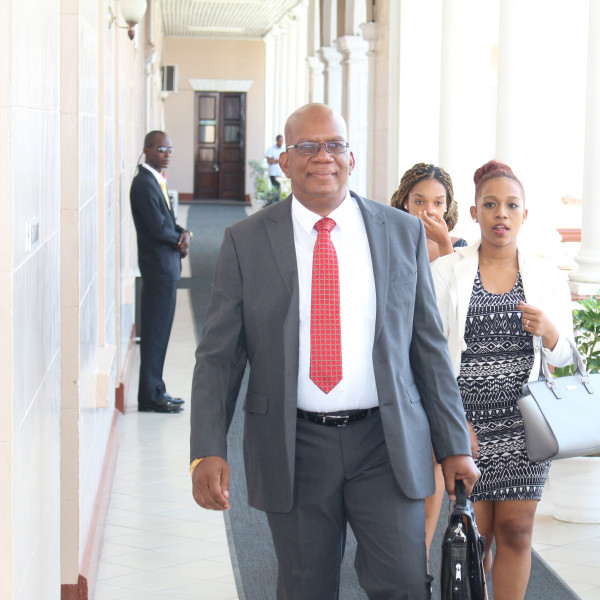Guyana’s economy is projected to grow 3.4% this year, a decrease from the 3.8% recorded last year reflecting a slowing of growth even as value-added and excise taxes collections are projected to rise by $3.8 billion to $69.5 billion this year.
Minister of Finance Winston Jordan in his Budget 2015 presentation yesterday said that the economy was slowing well before the APNU+AFC government came into power in May.
The 3.8 percent growth in 2014 was less than the original projection. The 2014 Budget by former Minister of Finance Dr Ashni Singh had projected a growth rate of 5.6 percent but this was revised mid-year to 4.5 percent. “Unfortunately, even that lower growth rate was not achieved, for the economy contracted to 3.8 percent. This was the first sign that the economy was slowing down, with the rapidly deteriorating political climate being identified as a significant contributory factor,” Jordan told the National Assembly as he presented his $221 billion 2015 National Budget to the House which was without the opposition PPP.

According to the Minister, the initial profile of the economy for 2015 showed that the previous Government was projecting a resurgence in growth to 5.3 percent, following the 3.8 percent growth achieved last year. Except for four sectors – sugar, bauxite, gold and wholesale and retail – modest growth was targeted for all sectors of the economy, he noted.
However, expectations for growth this year are lower given the poor performance of the economy in the first part of the year. “Mr. Speaker, with the benefit of the first half performance, the ambitious expectation of a 5.3 percent growth in 2015 has now been tempered to 3.4 percent. Growth in the first half of 2015, substantially a period when the former administration controlled the economy, was a miniscule 0.9 percent, well below the growth path required to attain a growth rate of 5.3 percent,” Jordan said.
Encouraging signs
“The failure of the economy to realize the planned growth rate in 2014, and the below par performance in the first half of this year, is conclusive evidence that the economy had slowed down long before our Government’s entry into office. There are, however, encouraging signs that there will be recovery in many sectors that will allow us to achieve the 3.4 percent revised growth rate,” he told the House.
Jordan said that for this year, Central Government current revenue is estimated at $163.7 billion, or 13.1 percent above collections in 2014. This will be attributed primarily to a 5.4 percent increase in tax collections by the Guyana Revenue Authority, he said.
Last year, Central Government current revenue, net of inflows from Guyana REDD+ Invest-ment Fund (GRIF), totalled $144.7 billion. Tax revenue collections amounted to $135.9 billion, representing 93.9 percent of total revenue. Internal revenue increased by $5.1 billion or 9.8 percent. Jordan said that this was primarily attributed to increased collections from private sector companies and a $2.7 billion increase in personal income tax from the Pay As you Earn (PAYE) category. On the other hand, there was a decrease of $581.6 million from withholding tax collections associated with the contraction in the gold mining sector. The minister said that for 2014, Value Added Tax (VAT) collections rose by 9 percent, to $37.5 billion, largely on account of better administration that resulted in arrears of $2.7 billion being recouped. Excise tax collections increased by 3.5 percent to $28.2 billion.
This year, VAT and excise tax collections are projected to grow by $3.8 billion to $69.5 billion. Internal revenue is targeted to increase by $3.7 billion or 6.5 percent, mainly the result of increased vigilance of private sector companies and the self-employed, according to Jordan.
Meantime, for this year, Customs and Trade Tax collections are estimated to decline by $128.6 million largely because of the repeal of the environment tax. Last year, Customs and trade tax collections totalled $13.5 billion.
“Non-tax revenue is projected to increase by $11.5 billion, mainly because of special transfers from statutory and non-statutory bodies,” Jordan said while noting that government has programmed a phased transfer of accumulated funds from such bodies as the Guyana Geology and Mines Commission, Guyana Forestry Commission and the National Frequency Management Unit.
Phased withdrawal
“This phased withdrawal does not amount to $60 billion quoted in some sections of the press, neither would it disrupt the lending portfolio of the commercial banks. This action is consistent with the Government’s stance to retrieve all revenues collected by statutory bodies that belong to the Consolidated Fund,” he said.
While Central Government’s current revenue is estimated at $163.7 billion, total expenditure is expected to grow by $7.3 billion, or 4 percent, to $192.2 billion. The three broad categories that comprise this total are: non-interest current expenditure, $146.3 billion; capital expenditure, $39.4 billion; and interest payments, $6.5 billion. The main driver of expenditure is the $12 billion support to the Guyana Sugar Corporation (GuySuCo), Jordan said.
He added that the deficit of the Central Government is projected to be 2.9 percent of GDP in 2015 compared with 5.5 percent in 2014 even as he acknowledged the compression of expenditure in the first eight months of the year.
“Mr Speaker, in spite of the late budget presentation, the size of Budget 2015 is $221 billion, which compares favourably with the $244 billion returned in 2014. Of this amount, some $97 billion is programmed to be spent on current and capital expenditure during the last four months of 2015, a stimulus if ever the economy needed one,” Jordan declared.
Earlier, he had disclosed that the inflation rate recorded for 2014 was 1.2 percent with relatively stable fuel prices contributing to the decline in price levels during the year. For this year, the initial projection for inflation was set at 2.5 percent but Jordan said that were the monthly marginal increases in the Consumer Price Index (CPI) recorded since January to continue, even if there were moderate increases in global fuel prices and consumer spending during the second half of the year, the inflation rate should not exceed 0.5 percent.
Further, the minister said, in 2015, the overall deficit of the balance of payments is projected to improve to US$113.4 million from US$116.4 million last year. “This improved deficit will be achieved because of a projected smaller deficit in the current account despite a substantial fall in net capital inflows,” he said.
Merchandise exports
Jordan pointed out that merchandise exports are estimated at US$1.1 billion, a small decline of 2.6 percent but merchandise imports are budgeted to fall even faster, from US$1.8 billion in 2014 to US$1.6 billion or 13 percent. “This leaves a net merchandise deficit of US$0.4 billion, or about two-thirds that of last year’s. Net services is projected to decline by 18.5 percent. Along with a small reduction in transfers, these movements are expected to result in a substantial improvement in the current account deficit, from US$0.4 billion in 2014, to US$0.2 billion in 2015. The capital account is estimated to deteriorate from US$210 million in 2014 to US$61 million in 2015,” he asserted.
Jordan said that at the end of 2014, Guyana’s total external debt stock stood at US$1.2 billion while the domestic debt stock stood at $78.4 billion at the end of 2014. He noted too that gross international reserves of the Bank of Guyana ended at US$665.6 million, equivalent to 3.6 months of import cover.
The minister had noted that in 2014, export earnings contracted by 15.1 percent to US$1.2 billion, largely on account of gold, sugar and bauxite. Gold export receipts declined by 27.6 percent to US$469.8 million, the result of a combination of a 20.1 percent contraction in export volume to 385,683 ounces and a 9.4 percent decline in average export prices, to US$1,218 per ounce.
Export earnings from bauxite contracted by 7.4 percent to US$124.7 million due to a 5.7 percent decline in export volume to 1,583,343 tonnes coupled with a 1.8 percent decrease in the export prices to US$78.80 per tonne.
Sugar export receipts fell by 22.9 percent to US$88 million. An 18.3 percent increase in export volume, to 189,565 tonnes was insufficient to compensate for the 34.8 percent decline in prices to US$464.30 per tonne. Rice exports earned US$249.5 million, a 4 percent increase. This was due to a 26.9 percent increase in export volume to 501,209 tonnes. Timber exports earnings amounted to US$53.4 million, an increase of 38.8 percent.
Meantime, merchandise imports contracted by 4.4 percent to US$1,791.3 million reflecting a contraction in all categories of imports. Imports of capital goods declined by 8.1 percent to US$387.5 million mainly due to a decline in imports of industrial machinery while non-fuel intermediate goods fell by 1.1 percent, to US$405.7 million. Fuel and lubricants decreased by 3.8 percent, to US$573.4 million, while consumption goods declined by 5 percent to US$415.7 million reflecting lower imports of other non-durables food for final consumption.
For 2014, net current transfers increased by 29.6 percent to US$457.6 million. Net payment of services declined by US$90.7 million due to a decline in non-factor payments. Net Factor services contracted by 6.6 percent to US$26.7 million.
The surplus on the capital account fell by one-third to US$210.1 million. This was attributed to a combination of lower disbursement of the non-financial public sector and higher inflows from foreign direct investment.
Gross international reserves of the Bank of Guyana ended at US$665.6 million, equivalent to 3.6 months of import cover while the surplus on the capital account fell by one-third to US$210.1 million. “This was attributed to a combination of lower disbursement of the non-financial public sector and higher inflows from foreign direct investment,” Jordan said.









